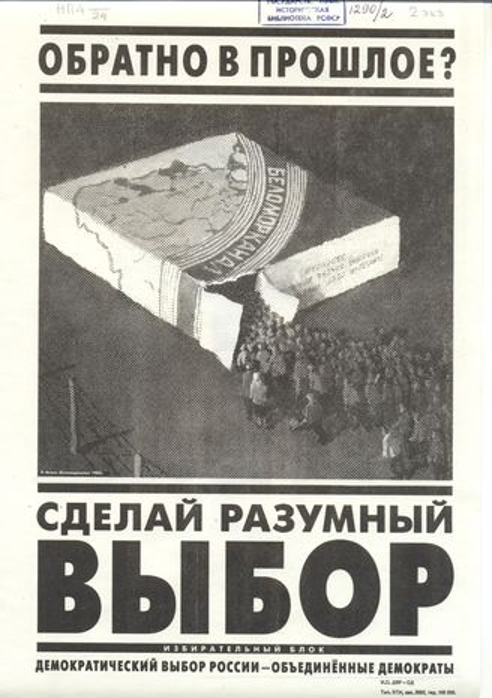Filed Under: Topic > Centrism > The Democratic Choice of Russia—United Democrats campaign for Duma seats in 1995
The Democratic Choice of Russia—United Democrats campaign for Duma seats in 1995

Top text: A return to the past?
Bottom text: Make the sensible choice. [Choose] the election bloc: Russia's Democratic Choice—United Democrats.
Bottom text: Make the sensible choice. [Choose] the election bloc: Russia's Democratic Choice—United Democrats.
The leaflet, although inventive in its allusion to the Belomor Canal as both a recognizable cigarette brand and a potent symbol of Stalinist atrocities, represents the failure of the reformist and neoliberal Democratic Choice of Russia (DCR) to form a coalition with the reformist and moderately socialist Yabloko (Apple) party. Various factors contributed to the disagreement, from DCR’s neoliberal orientation clashing with Yabloko’s socialist one, to the personal reluctance of Grigory Yavlinsky (1952-), the de facto leader of Yabloko, to compromise with other parties towards an alliance.
DCR was a powerful presence in the 1993 election cycle, when, under neoliberal shock therapist Yegor Gaidar, it captured 15.51% of the vote. But in 1995, the lack of a viable coalition meant that DCR only earned 3.86% of the vote, falling short of the 5% required to get Duma representation as a party. While the leaflets distributed by DCR in 1995 were visually striking, they were also contradictory, using visual devices gleaned from Soviet agitprop to deliver a largely negative message that threatened a return to Soviet oppression as an alternative to DCR victory. In short, DCR failed to articulate what it could offer besides resistance to the past.
The lack of a positive message that would forge unity, coming on the heels of Gaidar’s neoliberal reforms, solidified the marginalization of the DCR and Yabloko alike. Paradoxically, Yeltsin’s 1996 campaign made good use of mass media outlets to popularize the same message of resistance to Soviet totalitarianism, just one year after DCR’s failure. The inability of Russia’s center-right and center-left parties to reconcile around a unifying plan, vision, or oppositional strategy during the key elections of the ’90s facilitated, and paved the way for, the triumphant alliance of far-right and neoliberal factions under Putin’s banner by the end of the decade.